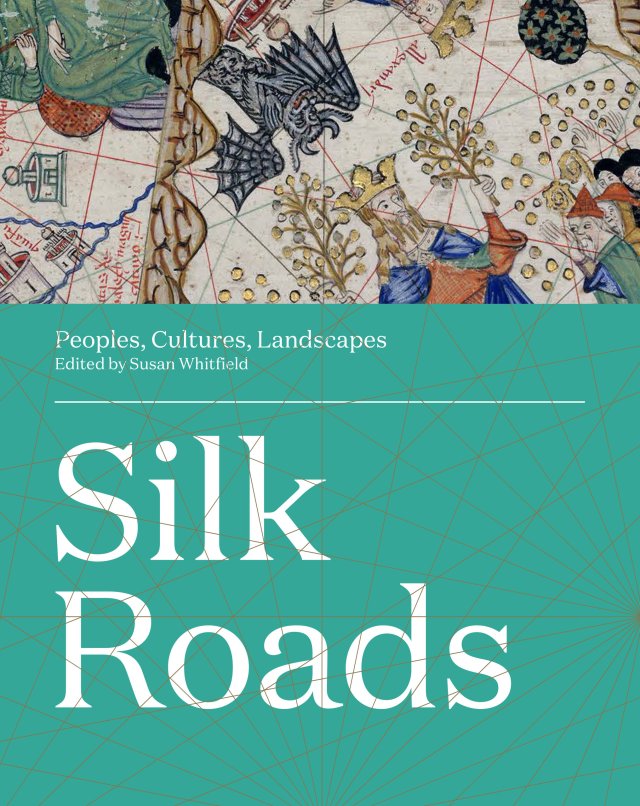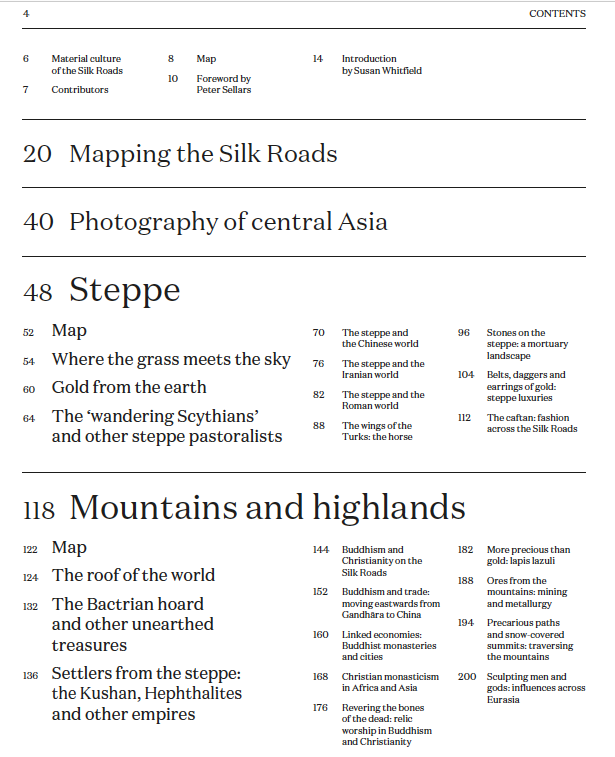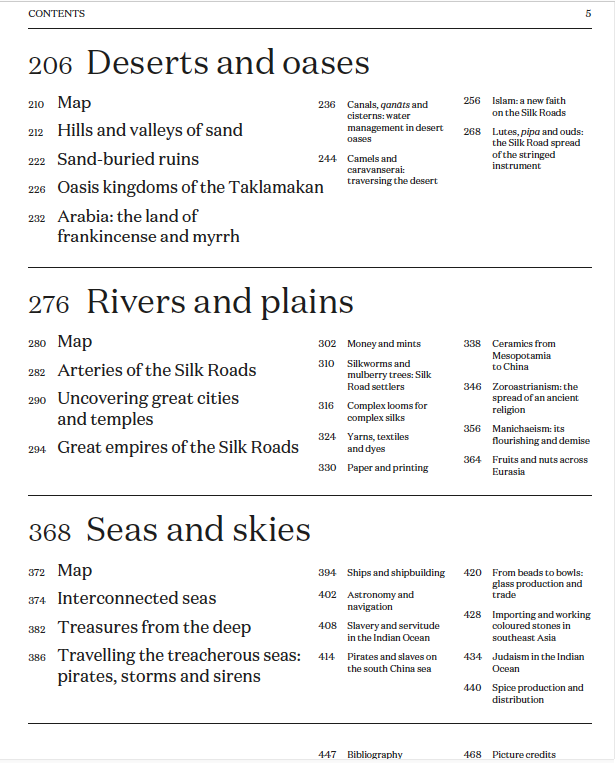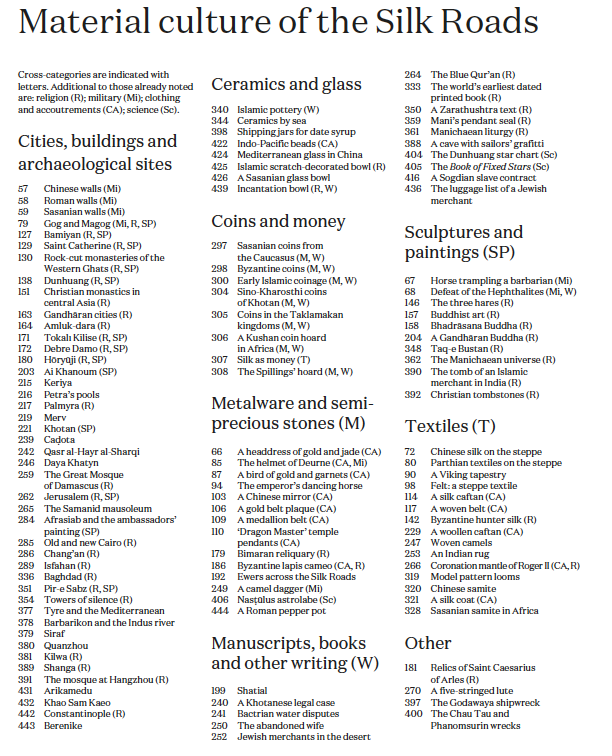
CONTENTS


EXCERPT FROM INTRODUCTION
There was no ‘Silk Road’. It is a modern label in widespread use only since the late 20th century and used since then to refer to trade and interaction across Afro-Eurasia from roughly 200 BE to AD 1400. In reality, there were many trading networks over this period. Some of these dealt in silk, yarn and woven fabrics. Others did not. Some started in China or Rome, but some in central Asia, northern Europe, India or Africa — and many other places. Journeys were by sea, by rivers and by land–and some by all three. Despite these ambiguities, the term has acquired a familiarity and brought regions and peoples often less well covered by modern historical writings to greater prominence and accessibility. It could also be argued that the growing popularity of the term has encouraged a more global historical viewpoint. For this reason I have referred to the ‘Silk Road’ – or perhaps slightly less misleadingly, the ‘Silk Roads’– unashamedly in my writings and exhibitions. If I were to provide a general definition of what I mean by the term – and how it is used in this book – it would be something like:
“A system of substantial and persistent overlapping and evolving interregional
trade networks across Afro-Eurasia by land and sea from the end of the 1st
millennium BC through to the middle of the 2nd millennium AD, trading in silk
and many other raw materials and manufactured items – including, but not limited
to, slaves, horses, semi-precious stones, metals, pots, musk, medicines, glass, furs and fruits – resulting in movements and exchanges of peoples, ideas, technologies, faiths, languages, scripts, iconographies, stories, music, dance and so on.”
…
Each section of this book starts with brief introductions to the landscapes of
Afro-Eurasia, to some of the many peoples and cultures inhabiting these landscapes over the Silk Road period, and to the uncovering of their archaeological legacy.
The book is structured by the types of landscape through which the Silk Road
networks passed – steppe, mountains and highlands, rivers and plains, deserts and oases, and seas. The skies are common to all, but included with seas because of their role in maritime navigation. These are no more than broad and permeable divisions: rivers rise in mountains, emerge into plains and disperse into seas or desert sands. Nor are they intended to be comprehensive: this is not a book on the complex ecosystems of Afro-Eurasia. But the landscape is an essential character in any Silk Road story, and too often given only a minor role.
The landscape, however, can also bias or limit our viewpoint. It preserves and
destroys without discrimination. For example, the desert sites of eastern central Asia and north Africa have yielded numerous silks, local and imported. But the monsoons have long destroyed south Asia’s textile legacy and we can only reconstruct it from clues in historical texts, from paintings and other artifacts and, very importantly, from textiles exported to distant lands, such as the desert settlements of Cadota and Antinopolis. In recent times, the legacy of the sea has started to be uncovered with the growth of maritime archaeology. The hulls of long-sunk ships have preserved their cargoes of ceramics and glass, but direct evidence of the human cargoes of slaves – very much part of Silk Road trade – has long disappeared. Wherever it is possible, or known, such absence is noted.
…
As well as the objects considered in the thematic essays, each section showcases
around twenty artefacts (see list below), from complex architectural or archaeological structures, such as cities or shipwrecks, down to small objects, such as glass beads. As well as illustrating the various topics discussed, the showcased items also exemplify interaction, having been influenced from elsewhere in their materials, form or motifs, and/or having themselves travelled along some of the Silk Road networks. Some of the artefacts are oft-reproduced, but I have also tried to include some lesser-known and newly excavated objects. These are not always the most spectacular or best preserved, but have an important part in the story. The story of the Silk Roads is not only one
of luxury goods.
In part because of its long timescale but, more crucially, because it covers areas of the world that are not part of the cultural and historical landscape of most readers – whether from Africa, Asia, Europe or America – the study of the Silk Roads can be daunting. A plethora of unfamiliar names and places can confuse and befuddle. I beg the reader’s patience to try not to be distracted by these. This work is intended, like one of the complex weaves discussed in the looms and textile essays to reveal a design through an interweaving of layers of numerous coloured threads. Reading one essay or caption may show little, but looking at more will, I hope, start to reveal something of the complex pattern of the Silk Roads.
I am delighted that so many of the leading scholars from institutions worldwide
have contributed to this book, some with thematic essays and others describing
objects they have excavated or studied. Understanding anything about the Silk Roads demands collaboration across cultures and languages. The diversity of styles and the different opinions expressed by the contributors is also key to this volume: it, too, is part of the weave.

The book is published on 3 October 2019 in the UK by Thames&Hudson and is also available in French (Flammarion), German (WBG), Spanish (BLUME), Finnish (Tammi), Italian (Einaudi) and Korean (Cum Libro) language editions as well as in a US edition by University of California Press.

Pingback: New Book: Silk Roads: Peoples, Cultures, Landscapes — Silk Road Digressions – jetsetterweb